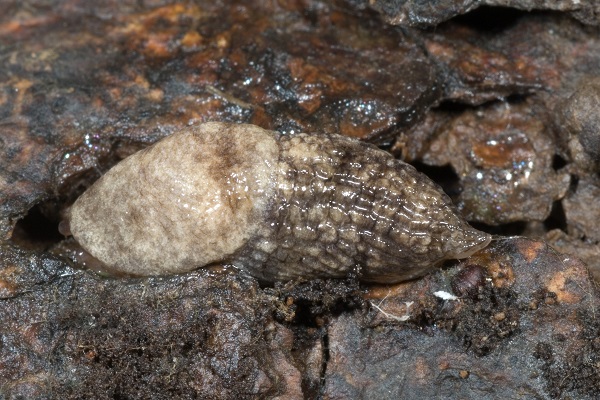Slugs
ENTFACT-407: Slugs | Download PDF
by Ric Bessin, Extension Specialist
University of Kentucky College of Agriculture
Slugs are common pests during wet weather and can damage many types of plants in the garden. Slugs are fleshy, slimy animals that feed mainly at night. They prefer cool, moist hiding places during the day. They range in color from light gray to black. Cool, wet spring conditions favor slug problems.

Figure 1. A common slug laying eggs.
Slugs rasp on leaves, stems, flowers and roots. They produce holes in the leaves or just scar the leaf surface. Small seedlings in the garden can be especially vulnerabIe to these creatures. Silvery slime trials are evidence of slug infestations. Here are a few tips on how to prevent or reduce slugs problems:
- Sanitation. Keep the area free of plant debris (leaves, prunings, pulled weeds, etc.), old boards, stones, or tires that provide cool moist hiding places for slugs.
- Prune low branches or trees or shrubs which touch the ground. Rake the leaves or mulch in order to allow the ground to dry.
- Metaldehyde, methiocarb, or iron phosphate baits can be used to kill slugs. Read the label carefully: some slug baits can be toxic to non-target organisms including humans, pets, and wildlife. Do not allow pellets to come in contact with leaves of edible plants.
- Beer traps. Empty cans buried up to the lip and partially filled with beer can be effective slug traps. Beer should be changed every few days to remain effective.
- Barriers of diatomaceous earth, wood ash, lime, sawdust, copper striping, and salt embedded plastic strips can be used around bedded plants.
Some of these tactics are more effective than others. Barriers of diatomaceous earth, sawdust, wood ash, and lime may need to be replaced after each rain. Do not use barriers of salt, this can damage your soil. A combination of two or more of these measures should control your slug problems.

Figure 2. Slug species vary in size and color.
Field Guide
For a detailed guide to the slugs that are found in Kentucky, including pictures and a scientific key, visit SR 103: A Field Guide to the Slugs of Kentucky (PDF).
Revised: 11/19
CAUTION! Pesticide recommendations in this publication are registered for use in Kentucky, USA ONLY! The use of some products may not be legal in your state or country. Please check with your local county agent or regulatory official before using any pesticide mentioned in this publication.
Of course, ALWAYS READ AND FOLLOW LABEL DIRECTIONS FOR SAFE USE OF ANY PESTICIDE!
Images: Ric Bessin, University of Kentucky Entomology.
